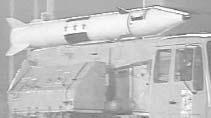- that while sanctions remain effective Iraq would not be able to produce a nuclear weapon. If they were removed or prove ineffective, it would take Iraq at least five years to produce sufficient fissile material for a weapon indigenously. However, we know that Iraq retains expertise and design data relating to nuclear weapons. We therefore judge that if Iraq obtained fissile material and other essential components from foreign sources the timeline for production of a nuclear weapon would be shortened and Iraq could produce a nuclear weapon in between one and two years.
BALLISTIC MISSILES
Joint Intelligence Committee (JIC) Assessment: 1999–2002
- In mid-2001 the JIC drew attention to what it described as a “step-change” in progress on the Iraqi missile programme over the previous two years. It was clear from intelligence that the range of Iraqi missiles which was permitted by the UN and supposedly limited to 150kms was being extended and that work was under way on larger engines for longer-range missiles.
- In early 2002 the JIC concluded that Iraq had begun to develop missiles with a range of over 1,000kms. The JIC assessed that if sanctions remained effective the Iraqis would not be able to produce such a missile before 2007. Sanctions and the earlier work of the inspectors had caused significant problems for Iraqi missile development. In the previous six months Iraqi foreign procurement efforts for the missile programme had been bolder. The JIC also assessed that Iraq retained up to 20 al-Hussein missiles from before the Gulf War.
The Iraqi ballistic missile programme since 1998

|
| FIGURE 4: ABABIL-100 |
- Since the Gulf War, Iraq has been openly developing two short-range missiles up to a range of 150km, which are permitted under UN Security Council Resolution 687. The al-Samoud liquid propellant missile has been extensively tested and is being deployed to military units. Intelligence indicates that at least 50 have been produced. Intelligence also indicates that Iraq has worked on extending its range to at least 200km in breach of UN Security Resolution 687. Production of the solid propellant Ababil-100 (Figure 4) is also underway, probably as an unguided rocket at this stage. There are also plans to extend its range to at least 200km. Compared to liquid propellant missiles, those powered by solid
27
